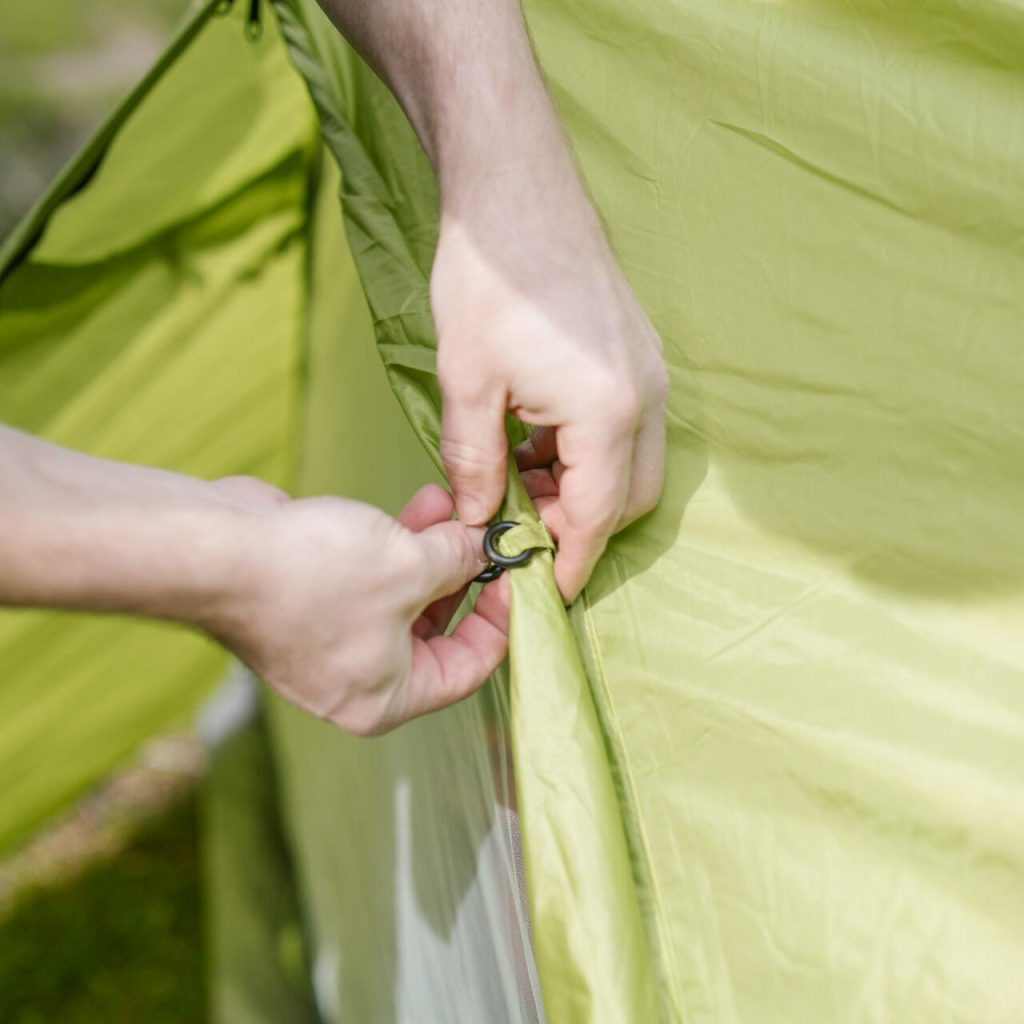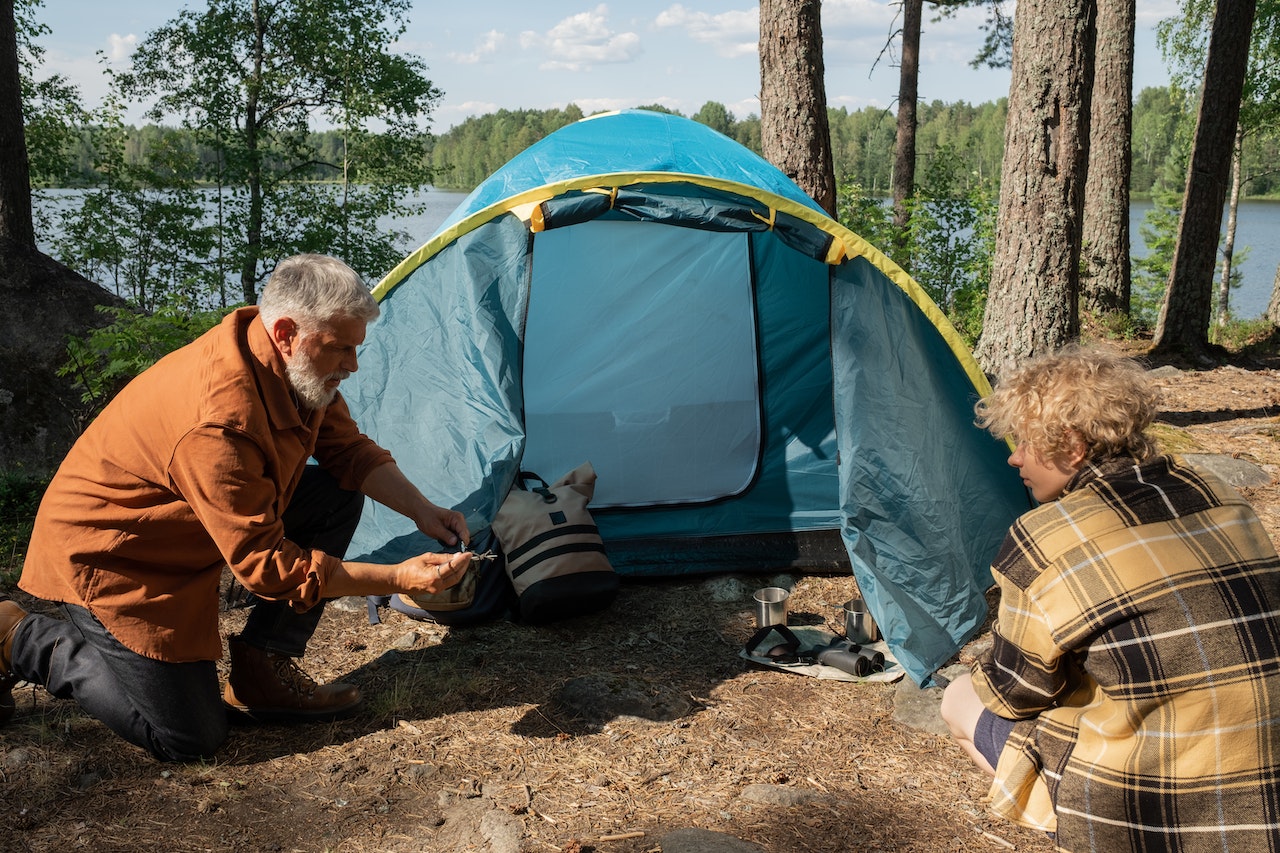A functional tent is essential for a successful camping trip. However, tents are prone to wear and tear, and it’s not uncommon for them to need repairs at some point. Whether it’s a small tear in your tent, a broken zipper, or damaged poles, there are steps you can take to fix common issues and keep your tent in good shape. This article will discover how to repair a ripped tent, from assessing the damage to waterproofing the fabric. With the right tools and some know-how, you can fix most common tent issues yourself and keep your tent in perfect condition for many camping trips to come.
Assessing the Damage
Table of Contents
ToggleTo properly assess the damage to your camping tent, you’ll need to take a close look at the affected area and determine the extent of the damage. This will help you decide on the best course of action to take. Here are some tips for assessing the damage to your tent:
Identify the Location of the Damage:
Is it a small tear, a hole, a broken zipper, or damaged poles? Knowing the specific area of the damage will help you determine how to approach the repair best.
Determine the Damage’s Extent:
Is it superficial, or is it structural? A small tear or hole can often be repaired with tent repair tape or adhesive patches, while more extensive damage may require more advanced repair techniques or even replacement.
Gather the necessary Tools and Materials:
Once you understand the location and extent of the damage, it’s time to gather the tools and materials you’ll need to repair it. This may include tent repair tape or patches, a zipper repair kit, splinting materials for broken poles, or a waterproofing spray or treatment.
Use a Tent Repair Kit
When your tent is used or has no repair kit available, purchase it and have it ready. A quality tent repair kit must include the proper tent pole splint, adhesive or seam ripper, needles, threads, and cleaning tools. Several even come equipped with zipper repair tools. Slide the splint onto the broken section on the pole and secure it with duct tape. When you don’t have a splint for fixing poles, you could use a tent stake to secure it.
How do I fix Holes and Small Tears in my Tent?
Small tears and holes in your tent can often be easily repaired with tent repair tape or adhesive patches. These products are specifically designed to fix small tears and holes in tent fabric, and they can be found at most outdoor or camping stores. Here’s how to use tent repair tape or adhesive patches to fix small holes or tears in your tent:
- Clean the affected area:
Before applying the repair tape or patch, cleaning the affected area is essential. Use a soft cloth or brush to remove dirt, debris, or loose threads from the tear or hole. - Cut the repair tape or patch to size:
Measure the size of the tear or hole and cut the repair tape or patch to match. If using repair tape, cut it into a shape that will cover the entire tear or hole with a bit of overlap onto the surrounding fabric. - Apply the repair tape or patch:
Follow the instructions on the packaging to apply the repair tape or patch. For repair tape, remove the backing and press the tape onto the tear or hole, making sure to smooth out any bubbles or wrinkles. For adhesive patches, remove the backing and press the patch onto the tear or hole, again making sure to smooth out any bubbles or wrinkles. - Allow the repair tape or patch to dry:
Once the repair tape or patch is applied, Follow the drying instructions on the package. This may take several hours or overnight, depending on the product you are using.
Check for Leaks Before You Leave
While camping, you don’t get a chance to discover a leak. Several leakages could easily be corrected on the field. However, significant issues with the tent’s seams and waterproofing must also be addressed. Also, check out the tents if there are leaky seams or weak seams. If you find these problems early on, it’s possible to reduce the risk of a big leak in the area. When inspecting the tent, check every part of the tent body and the tent to make sure there is no rubbing or wear to the seams.
How to Fix Leaks in a Tent
Leaks can occur from tears in a tent’s fabric. Please follow the given steps to resolve this issue. The common place where a leak can occur in tents is at the seam where they overlap. Using alcohol or tent cleaner, wipe out water from your skin before applying seam sealer. Most modern tents are covered in waterproof membranes that can eventually release some water. Liquids and detergents may damage the membrane, so wash clothing near tents carefully before using. Upon request, you may reapply the coating using an evaporator nozzle.
Use Gear Tape
When the tent leaks during a camping trip, it may be more costly. Small holes and easy-to-spot seam leaks may be temporarily fixable by placing gear tape in an empty area outside.
Mesh Repairs
If a tear from meshing a tent is visible, put a mesh patch under it rather than a gear tape. It is a simple repair that could be performed in or outside a large field if the mesh tears are dry. Even when your mesh hole doesn’t have enough room or space for bugs, it is necessary to go for a mesh patch.
Waterproofing
Waterproofing your tent is important in maintaining its functionality and extending its lifespan. Over time, the waterproof coating on your tent can wear off, leaving it vulnerable to water damage. You’ll need a waterproofing spray or treatment to re-water your tent.
Here’s how to do it:
- Clean the tent:
Before waterproofing your tent, it’s important to clean it thoroughly. Use light soap and warm water to wash the tent fabric and rinse it well. Allow the tent to dry completely before proceeding.
- Apply the waterproofing spray or treatment:
Follow the manufacturer’s instructions for applying the waterproofing spray or treatment. This may involve spraying or brushing the treatment onto the tent canvas or applying a sponge or cloth. Be sure to cover the entire tent, particularly in areas prone to wear and tear, such as the zippers, corners, and seams.
- Allow the treatment to dry:
Once you have applied the waterproofing treatment, allow it to dry according to the manufacturer’s directions. This may take several hours or overnight, depending on the product you are using.

How Do You Repair A Tent Seam?
Repairing an open patch is critical because tiny tears can quickly spread and cause more holes in the tent’s most vital weak points. Start your repairs using Seam Grip waterproof coating to protect from weather and moisture. Go to a fabric store and tuck the nylon and polyester yarn seams. This combination of seam-gripping thread and a tack is ideal for repairing your tent and providing many more seasons of use.
Polyurethane Sealer (Rainfly Window Repair)
You may have a window containing polyurethane that needs replacing to seal them. Even in old tents and those that are well-used, it is best to keep the windows open when you need them. Check out this waterproof sealer for windows made from the same material. If you replace the glue, remove the dry, flaky glue and place the seam on it first. Apply sand and water to the tent that has to be repaired. Allow it to dry, and do not use seam sealants on dry fabrics.
How to Fix a Broken Tent Pole?
A typical problem at campsites is the broken tent pole. It could occur from strong winds, over-zealous people setting up tents, people sitting on your tents, and wearing and tearing. Take some spare tent poles and replace all breaks immediately.
However, with some simple splinting techniques, you can often repair broken tent poles temporarily until you can replace them.
Here’s what to do:
Assess the damage:
First, look at the broken pole and determine the extent of the damage. If the break is clean, you can splint the pole and use it until you can replace it. If the pole is severely damaged or bent, it may be best to replace it altogether.
Gather materials:
To splint a broken tent pole, you’ll need some thin, sturdy materials such as thin wooden dowels, plastic tent stakes, or small branches. You’ll also need some thin cord or string to tie the splint.
Splint the broken pole:
To splint the broken tent pole, place the two broken ends together as closely as possible and tie them in place with the cord or string. Then, place the thin, sturdy materials on either side of the break and tie them in place with the cord or string. This will create a temporary splint that will hold the broken ends of the pole together and provide some additional support.
Use the splinted pole with caution:
Once you have splinted the broken tent pole, you can use it tentatively until you can replace it. However, using the splinted pole with caution is essential, as it may be weaker than a fully intact pole. Avoid putting too much strain on the splinted pole; consider replacing it as soon as possible.
Use Manufacturer Parts
The simplest repair method for tent pole repair uses one spare piece specifically designed for the tent. The most common repair kits for tents bought in the market come with spare joints and parts. In the field, it’s impossible to use the replacement pole of the tent if the tent splint is attached to it.
Tenacious Tape & Seam Grip (Best Method)
The simplest way to fix tents is with tape with an adequate seam grip. This product will be helpful in various projects, including repairing a rip in a tent. The same applies to fixing ripped fabric on a waterproof rain jacket. To fix rips in a camping area after returning to your house, wash away all faulty equipment you used to fix the problem while on your trip. Immediately to ensure the best possible finish, remove any fabric around tents and remove unused threads that hang near where repairs are required. It is possible to steam the surface, and the fabric will be flat.
Zipper Issues
Zipper issues are common problems with tents and can be frustrating. Luckily, you can take a few simple steps to fix zipper issues and get your tent working smoothly again.
Here’s what to do:
- Clean the zipper:
If your zipper is stuck or hard to move, the first step is to clean it. Use a toothbrush or any soft brush to gently remove any debris or dirt that may be stuck in the teeth of the zipper.
- Lubricate the zipper:
If it is still difficult to move after cleaning, try lubricating it. You can use a specialized zipper lubricant or a soap bar to lubricate the zipper. Simply apply the lubricant or soap to the teeth of the zipper and work the zipper back and forth a few times to distribute the lubricant evenly.
- Use a zipper repair kit:
You may need a zipper repair kit if the zipper is damaged or broken. These kits have instructions and the necessary materials to repair a broken zipper. Alternatively, you can replace the zipper if the damage is too extensive to repair.
Prevention is Better than Cure.
In most aspects of life, prevention is more effective than cure, and if one can prevent damaging the tent, it can reduce the damage.
Inspect Before You Leave
Always be sure to take care of the tent before leaving home. This will ensure that any such repair occurs right after your outdoor trip.
Choose Your Tent Site Carefully
You may wish to keep your tent tidy during the camping period. Take a look at your campsite. Look for a strong rock or other obstruction that could create holes or damage and remove them to avoid damage.
Conclusion
Learning how to repair a camping tent is essential for any outdoor enthusiast. Whether you’re dealing with small tears, zipper issues, pole damage, or a lack of waterproofing, there are steps to fix common tent issues and keep your tent in top condition. Following the tips and techniques outlined in this article, you can repair your tent and extend its lifespan, ensuring it’s ready for all your future camping adventures. Remember to regularly maintain and repair your tent; it will be a reliable shelter for many future trips.
Fix Rips, Leaks, and Broken Poles to Prolong the Life of Your Tent
FAQs
What is the Best Glue for Tents?
The best glue for tents will depend on the specific repair you need to make and the materials you are working with.
Here are a few options to consider:
- Seam Grip WP:
Seam Grip WP is a waterproof glue for repairing tent seams and other outdoor gear. It dries clear and remains flexible, making it a good choice for repairing tent fabric or other flexible materials.
- Gear Aid Seam Grip Sil:
Gear Aid Seam Grip Sil is another waterproof glue specifically designed to repair outdoor gear. It is silicone-based and dries clear, making it a good choice for repairing tent fabric or other flexible materials.
- Gear Aid Seam Grip WP+:
Gear Aid Seam Grip WP+ is a stronger, more durable version of the Seam Grip WP glue. It is specifically designed for repairing heavy-duty gear such as backpacks and is a good choice for repairing tent fabric or other durable materials.
Choosing a waterproof glue specifically designed for outdoor gear is best, as it will be more water-resistant and wear and tear.
Be sure to follow the manufacturer’s instructions for the best results.
Is it worth patching?
Whether it is worth patching a tear in a canopy tent depends on the size and location of the tear and the overall condition of the tent. If the tear is small and the tent is in good condition, patching may be a good option. However, if the tear is large or the tent is in poor condition, investing in a new tent may be more cost-effective.
Thanks for reading!




